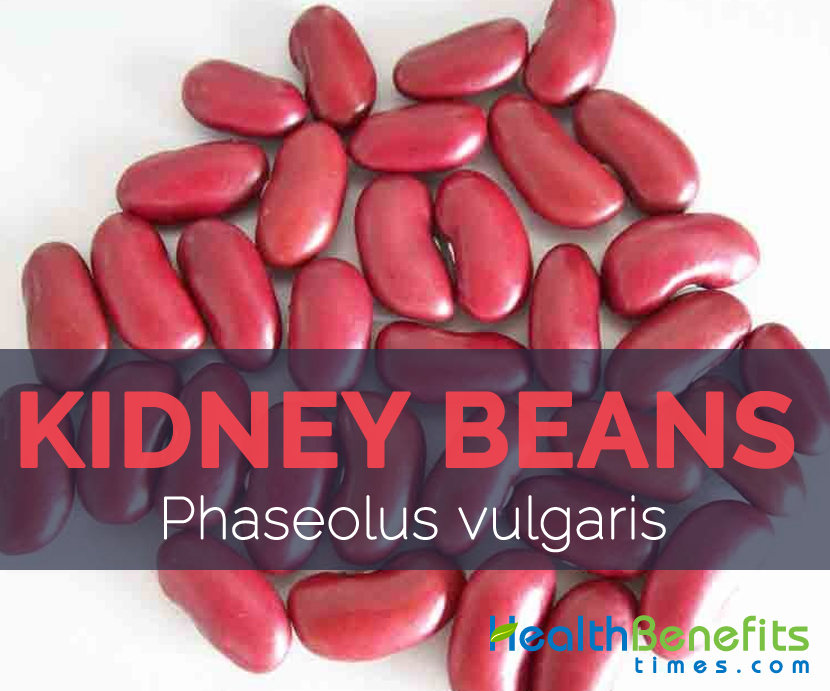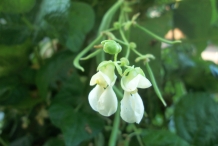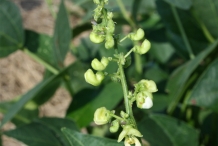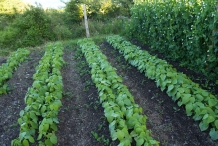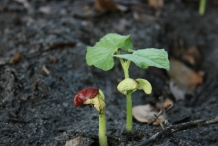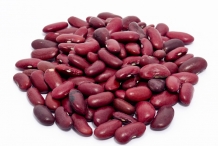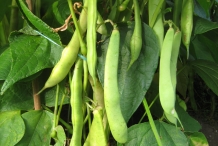Plant
A kidney bean is an annual, climbing or sub-erect herbaceous bush growing 3 meters long. It is found growing in tropical and temperate zones. It prefers medium-textured, well drained, organic rich soils over 0.5 m deep. It cannot tolerate high soil acidity and the related aluminum and manganese toxicities. It has well-developed taproot along with many lateral roots. It has 2–3 m long pubescent stem, turns glabrescent when old. Leaf is trifoliolate, alternate on 4–9 cm long petiole. Leaflets are 4–16 cm long, 2.5–11 cm broadly ovate to ovate-rhombic, acuminate, and apex, rounded to broadly cuneate base. Flower is papilionaceous, bisexual. Corolla is white, purple, yellow or pale pink, standard 9–12 mm long and glabrous. It is found blooming during July to September.
Fruit
Kidney beans are 8–20 cm long by 1–2.5 cm wide, linear-oblong legume, black, green, purple, yellow, pink, white-pink spotted in color, slightly curved to broadly undulating, turgid, glabrous, and beaked. One Kidney bean consists of 4–10 rounded kidney-shaped, ellipsoid or oblong and 2 cm long seeds which are pink, black, white, brown, red, spotted or variegated in 2 colors. A seed normally have dark red skin and has cream-colored flesh. It has mild flavor which is mostly suitable for soups, vegetables and many more. Beans are used for burns, dysentery, acne, bladder, diabetes, cardiac, carminative, dropsy, depurative, diuretic, diarrhea and many other problems.
History
Kidney bean is usually supposed to have originated in the Americas, with two centers of domestication. The small seed varieties were proposed to have domesticated from small-seeded wild type in Central America and the large-seeded varieties from large-seeded type in the Andean region of South America. Spaniards and Portuguese have taken to Europe, later they also took them to Africa and other parts of the Old World. Currently they are broadly grown in the tropics, subtropics and temperate regions. They are less identified in India, where other pulses are favored.
Nutritional Value
Apart from their mild taste Kidney bean is a good source of nutrients, vitamins and minerals. Consuming 100 gram of kidney bean offers 35.6 mg of Vitamin C, 0.362 mg of Vitamin B1, 0.273 mg of Vitamin B2 0.174 mg of Copper, 3.024 mg of Vitamin B3, 47 µg of Vitamin B9, 0.89 mg of Iron and 4.83 g of Protein. Moreover many Amino acids like 0.214 g of Isoleucine, 0.248 g of Valine, 0.203 g of Threonine, 0.05 g of Tryptophan and 0.135 g of Histidine are also found in 100 gram of the fruit.
Calories 33 Kcal. Calories from Fat 5.22 Kcal.
| Kidney Bean Quick Facts | |
|---|---|
| Name: | Kidney Bean |
| Scientific Name: | Phaseolus vulgaris |
| Origin | Originated in the Americas |
| Colors | Red, black, white, brown, pink, mottled or variegated in 2 colors |
| Shapes | Rounded kidney-shaped, ellipsoid or oblong and 2 cm long. |
| Flesh colors | Cream-colored |
| Taste | Mild flavor |
| Calories | 33 Kcal./cup |
| Major nutrients | Vitamin C (39.56%) Vitamin B1 (30.17%) Vitamin B2 (21.00%) Copper(19.33%) Vitamin B3 (18.90%) |
| Health benefits | Curing Cataracts (Eye Disorder), Antioxidants & Anti-aging Properties, Bone Strength, Alzheimer’s disease, Treatment of the Common Cold, Rheumatoid Arthritis, Relieves Fatigue, Cures Acne, Cardiovascular Benefits, Beneficial for digestive health |
| Proximity | Amount | % DV |
|---|---|---|
| Water | 89.3 g | N/D |
| Energy | 33 Kcal | N/D |
| Energy | 138 kJ | N/D |
| Protein | 4.83 g | 9.66% |
| Total Fat (lipid) | 0.58 g | 1.66% |
| Ash | 0.58 g | N/D |
| Carbohydrate | 4.72 g | 3.63% |
| Total Dietary Fiber | 6.40g | 16.84% |
| Soluble | 2.62 g | N/D |
| Insoluble | 3.77 g | N/D |
| Minerals | Amount | % DV |
|---|---|---|
| Copper, Cu | 0.174 mg | 19.33% |
| Iron, Fe | 0.89 mg | 11.13% |
| Manganese, Mn | 0.199 mg | 8.65% |
| Magnesium, Mg | 23 mg | 5.48% |
| Phosphorus, P | 38 mg | 5.43% |
| Potassium, K | 194 mg | 4.13% |
| Zinc, Zn | 0.44 mg | 4.00% |
| Calcium, Ca | 19 mg | 1.90% |
| Selenium, Se | 0.6 µg | 1.09% |
| Sodium, Na | 7 mg | 0.47% |
| Vitamins | Amount | % DV |
|---|---|---|
| Vitamin C (Ascorbic acid) | 35.6 mg | 39.56% |
| Vitamin B1 (Thiamin) | 0.362 mg | 30.17% |
| Vitamin B2 (Riboflavin) | 0.273 mg | 21.00% |
| Vitamin B3 (Niacin) | 3.024 mg | 18.90% |
| Vitamin B9 (Folate, Folic acid) | 47 µg | 11.75% |
| Vitamin K | 8.40 µg | 7% |
| Vitamin B5 (Pantothenic acid) | 0.381 mg | 7.62% |
| Vitamin B6 (Pyridoxine) | 0.093 mg | 7.15% |
| Vitamin A | 2 µg | 0.29% |
| Lipids | Amount | % DV |
|---|---|---|
| Fatty acids, total saturated | 0.083 g | 0.13% |
| Palmitic acid 16:00 (Hexadecanoic acid) | 0.074 g | N/D |
| Stearic acid 18:00 (Octadecanoic acid) | 0.01 g | N/D |
| Fatty acids, total monounsaturated | 0.045 g | N/D |
| Oleic acid 18:1 (octadecenoic acid) | 0.045 g | N/D |
| Gadoleic acid 20:1 (eicosenoic acid) | g | N/D |
| Fatty acids, total polyunsaturated | 0.318 g | 1.87% |
| Linoleic acid 18:2 (octadecadienoic acid) | 0.123 g | N/D |
| Linolenic acid 18:3 (Octadecatrienoic acid) | 0.194 g | N/D |
| Amino Acids | Amount | % DV |
|---|---|---|
| Isoleucine | 0.214 g | 12.80% |
| Valine | 0.248 g | 11.74% |
| Threonine | 0.203 g | 11.53% |
| Tryptophan | 0.05 g | 11.36% |
| Histidine | 0.135 g | 10.96% |
| Leucine | 0.347 g | 9.39% |
| Phenylalanine | 0.243 g | 8.37% |
| Lysine | 0.275 g | 8.22% |
| Cystine | 0.055 g | 3.29% |
| Methionine | 0.05g | N/D |
| Tyrosine | 0.166g | N/D |
| Arginine | 0.263 g | N/D |
| Alanine | 0.2 g | N/D |
| Aspartic acid | 0.628 g | N/D |
| Glutamic acid | 0.589 g | N/D |
| Glycine | 0.166 g | N/D |
| Proline | 0.195 g | N/D |
| Serine | 0.258 g | N/D |


